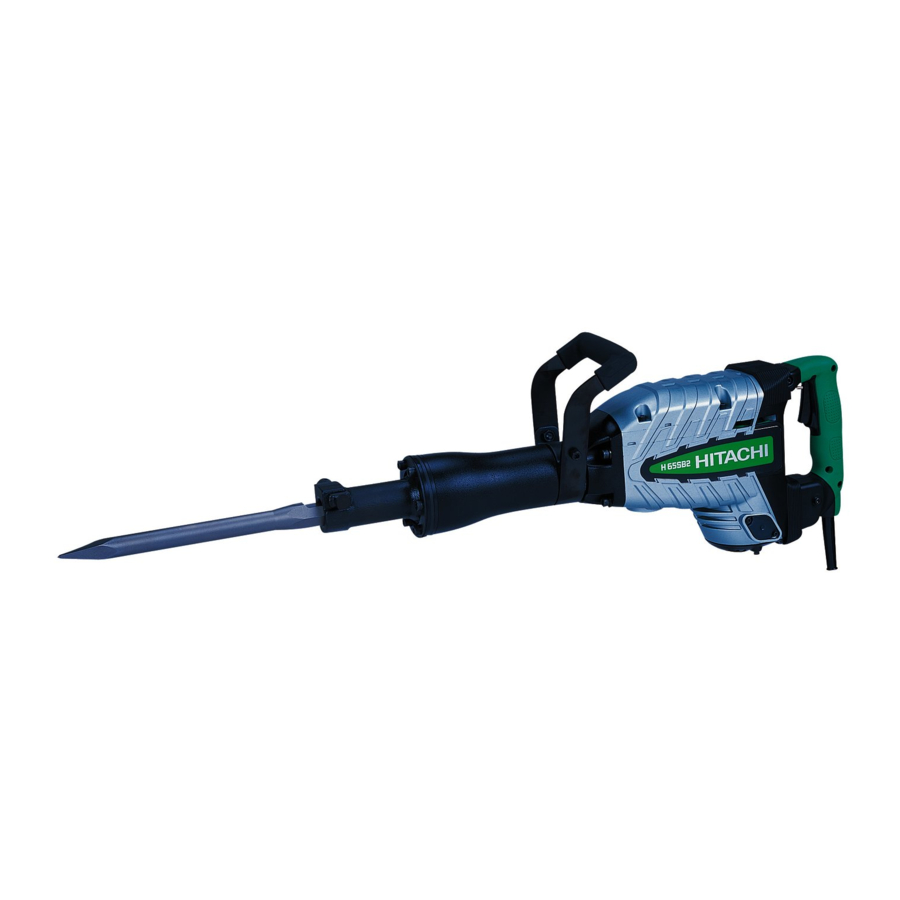Advertisement
DEMOLITION HAMMER
MODEL
INSTRUCTION MANUAL
Note:
Before using this HITACHI Demolition Hammer, carefully read through this
INSTRUCTION MANUAL to ensure efficient, safe operation. It is
recommended that this INSTRUCTION MANUAL be kept readily available as
an important reference when using this power tool.
H 65
Advertisement
Table of Contents

Summary of Contents for Hitachi H 65
- Page 1 H 65 INSTRUCTION MANUAL Note: Before using this HITACHI Demolition Hammer, carefully read through this INSTRUCTION MANUAL to ensure efficient, safe operation. It is recommended that this INSTRUCTION MANUAL be kept readily available as an important reference when using this power tool.
- Page 2 We sincerely thank you for selecting a HITACHI POWER TOOL. To operate this power tool safely and efficiently, please read this INSTRUCTION MANUAL carefully to get a good understanding of the precautions in operation, capacity of the power tool, use and the like.
- Page 3 Inspect extension cords periodically and replace them if damaged. Keep handles dry, clean, and free from oil and grease. 13. DISCONNECT POWER TOOLS. When not in use, before servicing, and when changing accessories, such as blades, bits, cutters. 14. REMOVE ADJUSTING KEYS AND WRENCHES. Form habit of checking to see that keys and adjusting wrenches are removed from the power tool before turning it on.
- Page 4 27. STOP OPERATION IMMEDIATELY IF ANY ABNORMALITY IS DETECTED. Should the power tool be detected as out of order or should other abnormalities be observed during operation, stop using the power tool immediately. 28. NEVER LEAVE THE POWER TOOL RUNNING UNATTENDED. TURN POWER OFF. Don’t leave the power tool until it comes to a complete stop.
- Page 5 GROUNDING INSTRUCTIONS This power tool should be grounded while in use to protect the operator from electric shock. The power tool is equipped with a three-conductor cord and three-prong grounding type plug to fit the proper grounding type receptacle. The green (or green and yellow) conductor in the cord is the grounding wire.
- Page 6 EXTENSION CORD Use only three-wire extension cords that have three-prong grounding-type plugs and three- pole receptacles that accept the power tool’s plug. Replace or repair damaged extension cord. Make sure your extension cord is in good condition. When using an extension cord, be sure to use one heavy enough to carry the current the power tool will draw.
-
Page 7: Name Of Parts
NAME OF PARTS SPECIFICATIONS Motor Power Source Current Full-Load Impact Rate: Weight ACCESSORIES CAUTION: Only following genuine accessories for this power tool should be used. The use of any other attachment or accessory is not recommended because it may cause hazard including bodily injury. -
Page 8: Prior To Operation
Prior to using this demolition hammer, remove the oil gauge and do not fail to fill the oil tank with the provided oil. (Although the oil tank is built in, it contains only a small quantity of oil when shipped from the HITACHI Works.) 7. Mounting an accessory, such as a bull point, a cutter, etc.. -
Page 9: Operation
NOTE: Use a manual hammer to open/close the retainer as it is too heavy to move by hand. Fig. 2 NOTE: When removing the accessory, such as a bull point, a cutter etc., follow the above procedure in reverse order. OPERATION OIL FEEDING CAUTION:... -
Page 10: Maintenance And Inspection
4. After feeding oil, securely clamp the oil gauge. NOTE: As an optional accessory, oil for the HITACHI Demolition Hammer (one liter) is sold separately. Use this oil when oil in the tank becomes less than the level indicated in Fig. 6 below. - Page 12 Cover Plate Hexagon Socket Hd. Bolt Oil Gauge Valve O-Ring (S-40) Felt Holder Hexagon Socket Hd. Bolt Issued by Shinagawa Intercity Tower A, 15-1, Konan 2-chome, Distributed by Hitachi Koki Canada Co. Item D6×36 M8×30 M8×35 M8×16 D8×25 M4×16 M5×20 D5×15.8 M4×12...












Need help?
Do you have a question about the H 65 and is the answer not in the manual?
Questions and answers